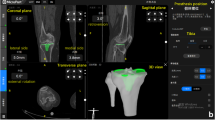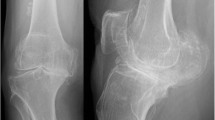Abstract
Purpose
Studies comparing clinical outcomes between manual (mTKA) and robotic-assisted TKA (raTKA) are limited. This prospective comparative cohort study aimed to compare early postoperative outcomes, satisfaction, and patient-reported outcome measures (PROMS) between patients undergoing mTKA and ROSA raTKA (Zimmer Biomet, Warsaw, IN) performed by one surgeon.
Methods
Thirty ROSA raTKAs and 30 mTKAs performed by one surgeon during 2020-2021 were prospectively evaluated. Groups were matched for age, sex, and body mass index. All procedures were primary unilateral TKAs using the same posterior-stabilized prosthesis (Nexgen Legacy, Zimmer Biomet, Warsaw, IN). Length of hospital stay (LOS) and blood transfusion rate were recorded. Complications, visual analogue scale score (VAS), and Oxford Knee Score (OKS) were assessed preoperatively and for six postoperative months. The Forgotten Joint Score (FJS) and patient satisfaction were evaluated 6 months postoperatively.
Results
No complications and similar blood transfusion rate were recorded between groups (p = 0.228). The LOS was non-significantly shorter in raTKA than in the mTKA group (p = 0.120). Mean preoperative and third-month OKS and VAS scores were comparable between groups. However, the mean 6-month OKS (p = 0.006) and VAS score (p = 0.025) were significantly better for the raTKA group. The 6-month FJS was significantly greater for raTKA than the mTKA group (p < 0.001). One patient was unhappy in raTKA, and three in the mTKA group (p = 0.301). Significantly more raTKA patients answered that they would undergo surgery again (p = 0.038).
Conclusion
raTKA was associated with the same complication risk, less pain level, better patient satisfaction, and PROMs on 6-month follow-up than the mTKA group.
Similar content being viewed by others
References
Kremers HM, Larson DR, Crowson CS, Kremers WK, Washington RE, Steiner CA, Jiranek WA, Berry DJ (2015) Prevalence of total hip and knee replacement in the United States. J Bone Jt Surg Am 97:1386–97. https://doi.org/10.2106/JBJS.N.01141
Kurtz S, Ong K, Lau E, Mowat F, Halpern M (2007) Projections of primary and revision hip and knee arthroplasty in the United States from 2005 to 2030. J Bone Jt Surg Am 89:780–5. https://doi.org/10.2106/JBJS.F.00222
El Bitar YF, Illingworth KD, Scaife SL, Horberg JV, Saleh KJ (2015) Hospital length of stay following primary total knee arthroplasty: data from the nationwide inpatient sample database. J Arthroplasty 30:1710–5. https://doi.org/10.1016/j.arth.2015.05.003
Batailler C, Hannouche D, Benazzo F, Parratte S (2021) Concepts and techniques of a new robotically assisted technique for total knee arthroplasty: the ROSA knee system. Arch Orthop Trauma Surg 141:2049–58. https://doi.org/10.1007/s00402-021-04048-y
Song E-K, Seon J-K, Yim J-H, Netravali NA, Bargar WL (2013) Robotic-assisted TKA reduces postoperative alignment outliers and improves gap balance compared to conventional TKA. Clin Orthop Relat Res 471:118–26. https://doi.org/10.1007/s11999-012-2407-3
Song E-K, Seon J-K, Park S-J, Jung WB, Park H-W, Lee GW (2011) Simultaneous bilateral total knee arthroplasty with robotic and conventional techniques: a prospective, randomized study. Knee Surg Sports Traumatol Arthrosc 19:1069–76. https://doi.org/10.1007/s00167-011-1400-9
Hampp EL, Chughtai M, Scholl L, Sodhi N, Bhowmik-Stoker M, Jacofsky D, Mont MA (2019) Robotic-arm assisted total knee arthroplasty demonstrated greater accuracy and precision to plan compared with manual techniques. J Knee Surg 32:239–50. https://doi.org/10.1055/s-0038-1641729
Marchand RC, Sodhi N, Khlopas A, Sultan A, Harwin S, Malkani A, Mont MA (2017) Patient satisfaction outcomes after robotic arm-assisted total knee arthroplasty: a short-term evaluation. J Knee Surg 30:849–53. https://doi.org/10.1055/s-0037-1607450
Smith AF, Eccles CJ, Bhimani SJ, Denehy KM, Bhimani RB, Smith LS, Malkani AL (2021) Improved patient satisfaction following robotic-assisted total knee arthroplasty. J Knee Surg 34:730–8. https://doi.org/10.1055/s-0039-1700837
Jacofsky DJ, Allen M (2016) Robotics in arthroplasty: a comprehensive review. J Arthroplasty 31:2353–63. https://doi.org/10.1016/j.arth.2016.05.026
Kayani B, Konan S, Tahmassebi J, Pietrzak JRT, Haddad F (2018) Robotic-arm assisted total knee arthroplasty is associated with improved early functional recovery and reduced time to hospital discharge compared with conventional jig-based total knee arthroplasty: a prospective cohort study. Bone Jt J 100(7):930–937
Parratte S, Price AJ, Jeys LM, Jackson WF, Clarke HD (2019) Accuracy of a new robotically assisted technique for total knee arthroplasty: a cadaveric study. J Arthroplasty 34:2799–803. https://doi.org/10.1016/j.arth.2019.06.040
Mannan A, Vun J, Lodge C, Eyre-Brook A, Jones S (2018) Increased precision of coronal plane outcomes in robotic-assisted total knee arthroplasty: a systematic review and meta-analysis. Surgeon 16(4):237–244
Clement ND, MacDonald D, Simpson AHRW, Burnett R (2013) Total knee replacement in patients with concomitant back pain results in a worse functional outcome and a lower satisfaction rate. Bone Jt J 95-B:1632–1639
Banger M, Doonan J, Rowe P, Jones B, MacLean A, Blyth MJB (2021) Robotic arm-assisted versus conventional medial unicompartmental knee arthroplasty: five-year clinical outcomes of a randomized controlled trial. Bone Jt J 103-B:1088–1095
Rossi SMP, Sangaletti R, Perticarini L, Terragnoli F, Benazzo F (2022) High accuracy of a new robotically assisted technique for total knee arthroplasty: an in vivo study. Knee Surg Sports Traumatol Arthrosc 4:1–9. https://doi.org/10.1007/s00167-021-06800-8
Siebert W, Mai S, Kober R, Heeckt PF (2002) Technique and first clinical results of robot-assisted total knee replacement. Knee 9:173–80. https://doi.org/10.1016/s0968-0160(02)00015-7
Kenanidis E (2019) Letter to the editor on “robot-assisted total knee arthroplasty does not improve long-term clinical and radiologic outcomes.” J Arthroplasty 34:2521. https://doi.org/10.1016/j.arth.2019.06.023
Dunbar NJ, Roche MW, Park BH, Branch SH, Conditt MA, Banks SA (2012) Accuracy of dynamic tactile-guided unicompartmental knee arthroplasty. J Arthroplasty 27:803-808.e1. https://doi.org/10.1016/j.arth.2011.09.021
Mofidi A, Plate JF, Lu B, Conditt MA, Lang JE, Poehling GG, Jinah RH (2014) Assessment of accuracy of robotically assisted unicompartmental arthroplasty. Knee Surg Sports Traumatol Arthrosc 22:1918–25. https://doi.org/10.1007/s00167-014-2969-6
Kim Y-H, Yoon S-H, Park J-W (2020) Does robotic-assisted TKA result in better outcome scores or long-term survivorship than conventional TKA? a randomized, controlled trial. Clin Orthop Relat Res 478:266–75. https://doi.org/10.1097/CORR.0000000000000916
Author information
Authors and Affiliations
Contributions
E. T and E. K contributed to the study conception and design. Material preparation, data collection, and analysis were performed by E. T, E. K, N. M, and G. P. The first draft of the manuscript was written by E. K, G. P, and M. P. All authors commented on previous versions of the manuscript. All authors read and approved the final manuscript.
Corresponding author
Ethics declarations
Conflict of interest
The authors did not receive support from any organization for the submitted work.The authors have no relevant financial or non-financial interest to disclose.
Additional information
Publisher's Note
Springer Nature remains neutral with regard to jurisdictional claims in published maps and institutional affiliations.
Supplementary Information
Below is the link to the electronic supplementary material.
Rights and permissions
About this article
Cite this article
Kenanidis, E., Paparoidamis, G., Milonakis, N. et al. Comparative outcomes between a new robotically assisted and a manual technique for total knee arthroplasty in patients with osteoarthritis: a prospective matched comparative cohort study. Eur J Orthop Surg Traumatol 33, 1231–1236 (2023). https://doi.org/10.1007/s00590-022-03274-3
Received:
Accepted:
Published:
Issue Date:
DOI: https://doi.org/10.1007/s00590-022-03274-3




